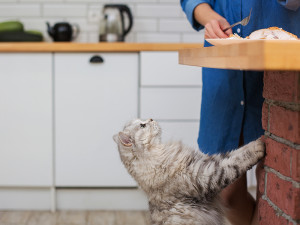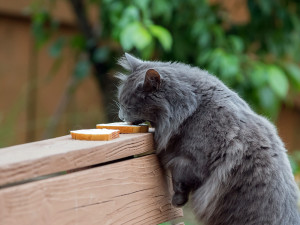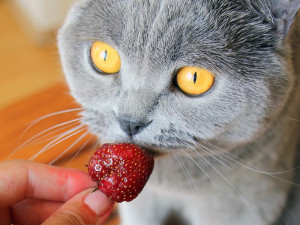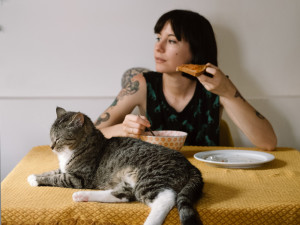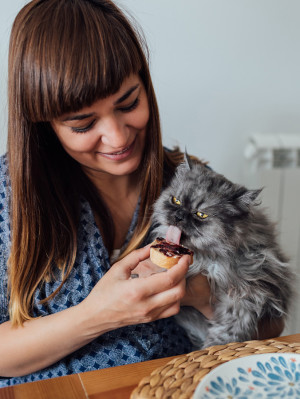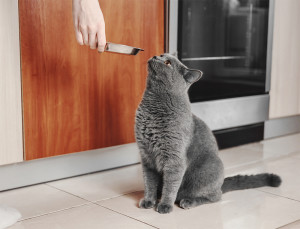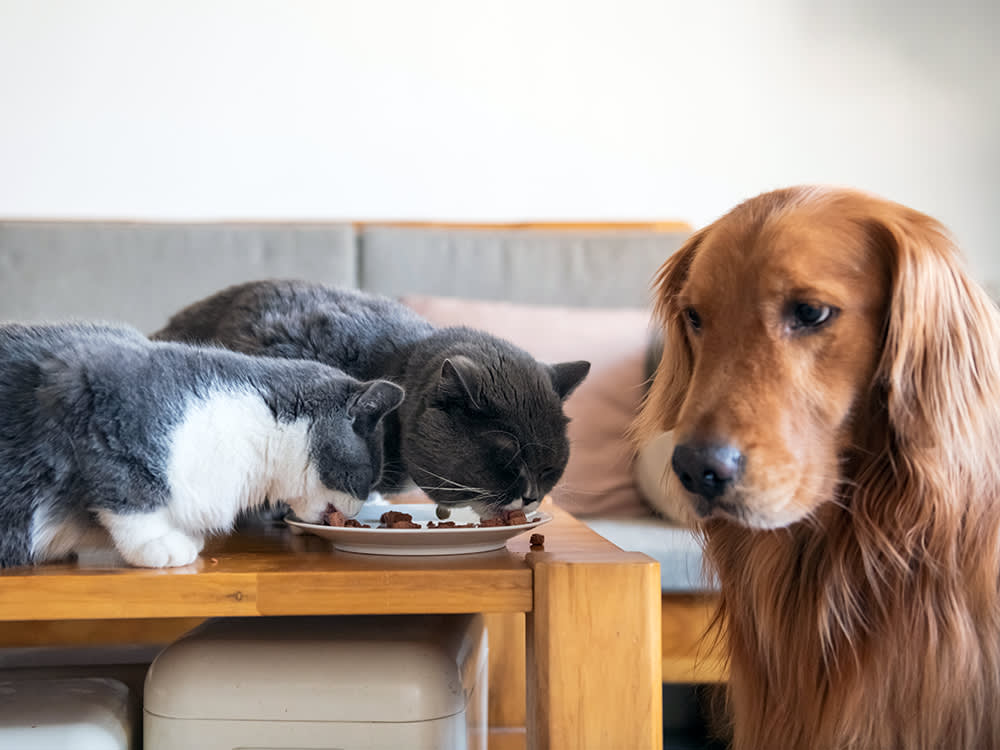
Share Article
In This Article:
Can Cats Eat Dog Food? Is It Safe for Cats to Eat Dog Food? Risks of Feeding Cats Dog Food What Are the Differences Between Cat and Dog Food? How to Stop Your Cat from Eating Dog Food Alternatives to Dog Food for Cats High Quality Commercial Cat Food Options
You know that meow. The one that says, It’s dinner time. Get to it, human. Hungry feline here. You open the pantry door — cat food, cat food, cat food. Where is the cat food anyway? Wait, here’s some dog food. Decision time, cat parent. Is it OK to feed your cat dog food?
Here’s what you should know before switching up the menu.
Can cats eat dog food?
The quick, but in no way complete, answer is yes. According to veterinarian Dr. Maryanne Murphyopens in new tab, clinical assistant professor of nutrition at the University of Tennessee, “There is nothing in dog food that’s not safe for cats to eat.”
How much do you spend on your pet per year?

But just like with humans, “Can you eat it?” and “Should you eat it?” are two very different questions.
Is it safe for cats to eat dog food?
Veterinarian Dr. Lindsay Butzer says yes, it is safe for cats to eat dog food but only if pet parents observe this important caveat — they must also feed them cat food. Experts say dog food is far safer than foods like chocolate, grapes, raisins, butter, alcohol, caffeine, spices, bones and citrus zest which are toxic for cats and should never be part of their diet.
Occasional consumption vs. regular diet
Dr. Murphy says frequency is the most important factor. “The issue is that cats have different nutrient requirements than dogs … and those levels won’t be achieved if you’re feeding your cat a dog diet long-term, but [one meal] isn’t cause for concern.”
Risks of feeding cats dog food
She warns that an abrupt switch in food, including a bowl of unfamiliar dog kibble, could cause some gastrointestinal distress in your cat, so watch for symptoms like diarrhea and vomiting.
Understanding carnivore and omnivore diets
Cats are obligate carnivores. Meat eaters. That means they need meat-based proteins and animal fats in their diet for their best health. Dr. Butzer says a high-protein diet is essential for tissue repair, energy production, and hormone production.
Dogs, on the other hand, are more omnivorous and have a more diverse diet of both plants and animals than cats. So, even though dog and cat foods might have several of the same ingredients listed on the label, cat foods also contain ingredients that aren’t used in dog food.
Essential nutrients needed by cats
Protein
Cat food is much higher in protein than dog food. Scientists have found that the feline high-protein diet is essential for their various bodily functions, including tissue repair, energy production, and hormone production.
Taurine
Cats need an animo acid called taurine, which is essential for their diet because it cannot be produced when ingested. Taurine is crucial for vision, specifically retinal degeneration. Dr. Butzer says if you notice a cat bumping into things or wandering around confused, they may need taurine. Taurine deficiency can also cause a heart ailment called dilated cardiomyopathy, a disease seen mostly in dogs, but lack of taurine causes it in cats.
Arachidonic acid
Cat food also contains arachidonic acid which supports skin and coat health and is also very important for fetal development and blood clotting. Unlike dogs, cats have limited ability to convert other fatty acids into arachidonic acid. Therefore, they must get it directly from their diet. Animal-based sources, such as meat and fish, are rich in arachidonic acid, making them ideal for your cat’s nutrition. Without higher amounts and specific omegas in a cat’s diet they will lack arachidonic acid to be healthy.
Vitamins
Low vitamin A causes dry eye and skin issues in cats and can lead to corneal ulcers and poor vision. Unlike dogs, who can convert beta-carotene into vitamin A, cats must get it through their diet to be healthy.
Also, Dr. Butzer says cats cannot convert sunlight through their skin into Vitamin D — they get their Vitamin D through diet. So, while your cat may love sitting in the sunshine, they won’t get their necessary Vitamin D that way.
Niacin
While dogs can synthesize some niacin from the amino acid tryptophan, cats cannot. Therefore, it is essential for cats to obtain niacin from their diet, Dr. Butzer says.
Calories
The added protein in cat food also adds calories, making cat food more calorie-dense than dog food. Your cat will need to eat larger amounts of dog food to meet their calorie requirements (but still won’t be getting the ideal nutrient balance).
Cats should avoid high fat foods because they can lead to gastritis, pancreatitis and feline obesity which can increase a cat’s risk for other health issues. “Remember that animals that maintain at a healthy weight throughout their lifetime can live an additional two years over that of an overweight pet,” Dr. Lori Teller says.
What are the differences between cat and dog food?
Taste
Don’t be surprised if your cat turns their nose up at a bowl full of dog food. Cat food has a stronger flavor and aroma to make it appetizing to finicky felines, and dog food lacks the appeal. If you discover that your cat has helped themself to the dog food bowl, don’t panic. Dog food isn’t toxic — just make sure that it’s not their main source of food: Cats need a complete and balanced diet formulated for their specific nutritional needs.
How to stop your cat from eating dog food
If your cat has acquired a taste for dog food — lack of essential nutrients and all — Dr. Butzer advises the simplest approach: Don’t feed it to them. Also, if you have both a dog and a cat in your living space, she advises this way to avoid dinner-time mix-ups. “Feed your dog in a different area and pick up the bowl,” she says.
Alternatives to dog food for cats
Barring dog food, there are many safe human foods for cats, like broccoli, cantaloupe, carrots, chicken, fish oil, green beans, pumpkin, salmon, sardines and turkey. These are all things that can be added in addition to the food you buy them. Dr. Butzer does not promote feeding your pet a strictly homemade diet.
High-quality commercial cat food options
Dr. Butzer recommends Royal Canin, which is sold at pet stores. Talk to your vet for other options they may recommend.

T. Kent Jones
T. Kent Jones is a writer and broadcaster whose work has been featured on The Daily Show on Comedy Central, The Rachel Maddow Show on MSNBC, Morning Sedition with Marc Maron on Air America Radio and in many publications and comedy websites. He lives in New York City with his wife, Kelly, and their rescue Schnoodle, Pops, who suffers much foolishness with stoic forebearance.
Related articles
![Dark grey cat eating two slices of break laid on top of a wooden railing of an outdoor deck]()
Can Cats Eat Bread?
Go ahead and give your carb-loving cat a few bites, but don’t hand over the bread basket.
![Grey cat eats a strawberry]()
Can Cats Eat Strawberries
Yes, strawberries are a nutritious treat for dogs.
![A woman eating peanut butter toast with her cat laying on the table]()
Can Cats Eat Peanut Butter?
The sweet-and-salty treat is OK in moderation.
Can a Kitten Eat Adult Cat Food?
Uhh, is that safe, little guy?
![Woman feeding her puffy cat at the table.]()
What Human Foods Can Cats Eat?
We know they’re begging—but what’s safe to share?
![Hand holding food bowl peeks into frame as a cat looks up expectantly]()
The Ultimate Puzzle: Picking the Right Cat Food
Four veterinary nutritionists pick apart the claims so that you can choose the right food for your kitty.

